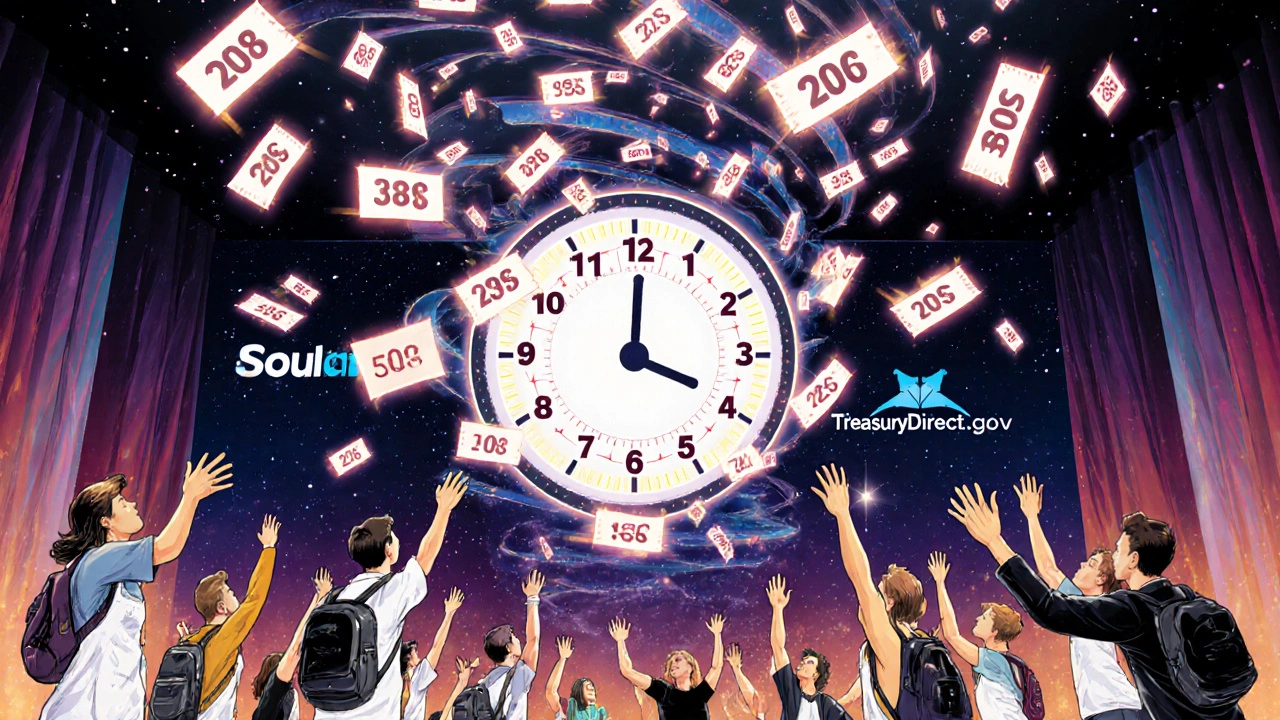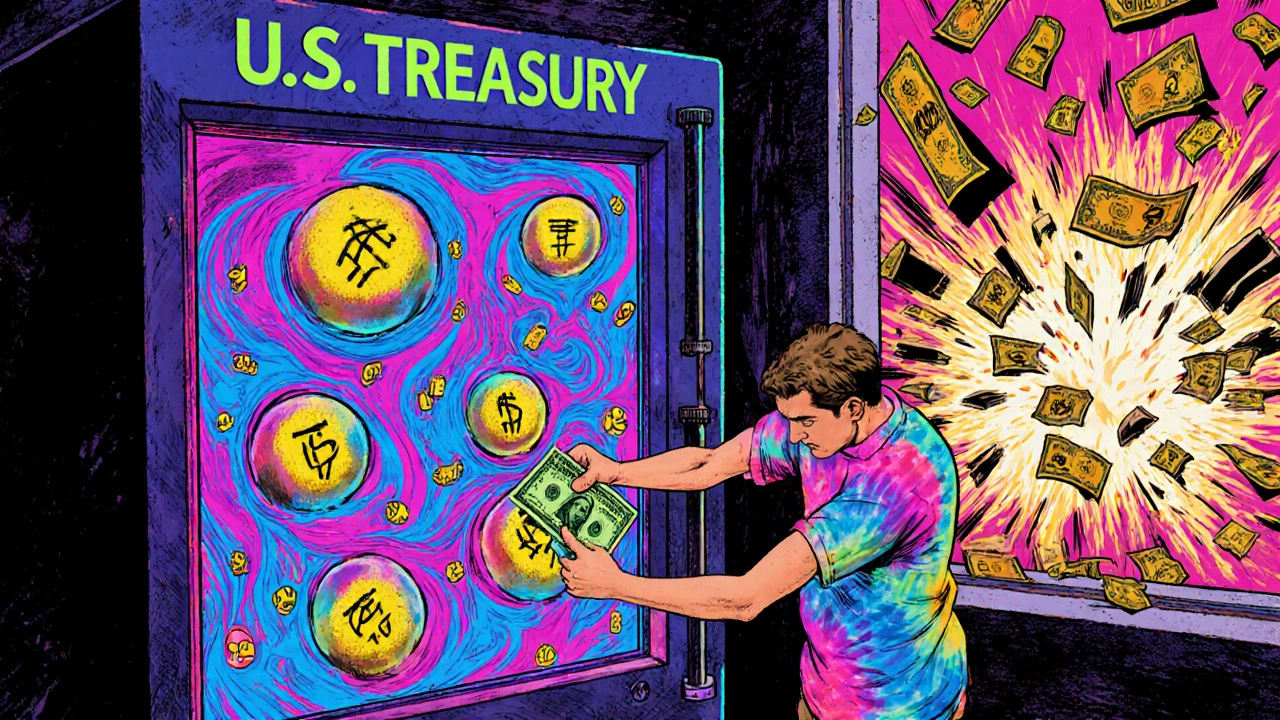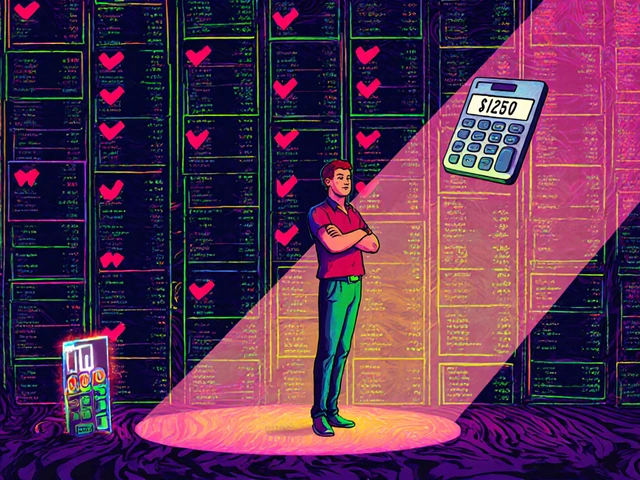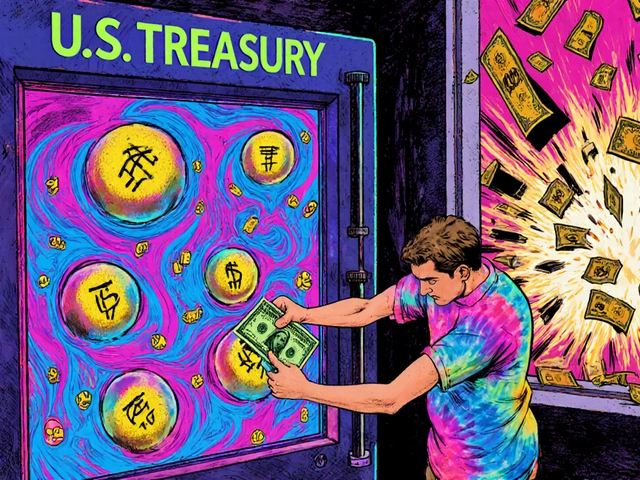Treasury Yield Calculator
Calculate your potential returns on U.S. Treasury securities based on current yields (as of October 2023).
When you hear the words Treasury bonds, you might think of boring government paperwork. But if you’re looking for a safe place to put your money - especially when the stock market feels like a rollercoaster - U.S. Treasury securities are one of the most reliable tools you can use. They’re not flashy. They don’t promise huge returns. But they deliver something even more valuable: certainty.
The U.S. government has never missed a payment on its debt. Not once. Not in 235 years. That’s not just a nice fact - it’s the foundation of global finance. Whether you’re saving for a house in five years, building an emergency fund, or trying to balance out your risky stock picks, Treasury securities offer a steady anchor. And the best part? You can buy them with as little as $100.
What Are Treasury Bills, Notes, and Bonds?
The U.S. Treasury issues three main types of debt: bills, notes, and bonds. They all represent loans you make to the federal government. In return, you get your money back with interest. The only real difference between them is how long you have to wait to get it back.
Treasury bills (T-bills) are short-term. They mature in one year or less. You’ll find them with maturities of 4 weeks, 8 weeks, 13 weeks, 17 weeks, 26 weeks, or 52 weeks. These aren’t like regular bonds that pay you interest every six months. Instead, they’re sold at a discount. If you buy a $1,000 T-bill for $970, you’re effectively earning $30 in interest when it matures. That’s it. No checks in the mail. Just a lump sum when the clock runs out.
Treasury notes (T-notes) are the middle ground. They come in 2-year, 3-year, 5-year, 7-year, and 10-year terms. These pay interest every six months. So if you buy a $1,000 10-year note with a 4.5% coupon rate, you’ll get $22.50 every six months for ten years - and then get your $1,000 back. Simple. Predictable.
Treasury bonds (T-bonds) are the long-term players. Since 2020, the U.S. has been issuing 20-year and 30-year bonds again. These also pay interest every six months, just like notes. But because they last longer, they’re more sensitive to changes in interest rates. If rates go up, the value of your 30-year bond drops. If rates go down, your bond becomes more valuable. That’s why they’re used more for long-term portfolio balance than for quick cash.
How Do They Compare?
Here’s the real question: which one should you buy? It depends on your timeline, your risk tolerance, and what else is going on in the economy.
Let’s look at the numbers as of October 2023:
| Security Type | Maturity | Interest Payments | Yield (Oct 2023) | Best For |
|---|---|---|---|---|
| Treasury Bill (T-bill) | 4 weeks to 52 weeks | None (sold at discount) | 5.25% | Emergency fund, short-term savings |
| Treasury Note (T-note) | 2 to 10 years | Semiannual | 4.65% (10-year) | Medium-term goals (college, down payment) |
| Treasury Bond (T-bond) | 20 to 30 years | Semiannual | 4.85% (30-year) | Long-term diversification, inflation hedge |
T-bills are the safest in terms of price swings. Because they mature so fast, interest rate changes barely touch them. That’s why so many people use them for cash reserves. If you’re worried about losing money in a market crash, T-bills are your insurance policy.
T-notes are where most investors live. They offer a decent yield without the wild ride of long-term bonds. If you’re saving for a child’s education or planning to buy a home in 5-7 years, a 5-year or 7-year note gives you a solid return without tying up your money for decades.
T-bonds are the quiet heroes. They don’t get much attention, but during the 2020 market crash, 30-year bonds rose 15.3% while the S&P 500 fell 34%. That’s the power of a long-term, low-risk asset when everything else is falling apart. They’re not for everyone - if you need to sell before maturity, you might take a loss if rates have gone up. But if you hold them to the end, you get every penny of interest, no matter what.
Why Do Yields Change - And What Does It Mean?
Yields on Treasury securities move with the economy. When the Federal Reserve raises interest rates to fight inflation, new T-bills and T-notes pay more. That makes older bonds with lower rates less valuable. So if you own a 3% bond and new ones are paying 5%, your bond’s market value drops.
That’s why the shape of the yield curve matters. Normally, longer-term bonds pay more than shorter-term ones. That’s called a normal yield curve. But in mid-2022, something unusual happened: 3-month T-bills were paying 5.4%, while 10-year notes were only paying 3.85%. That’s called an inverted yield curve. And historically, it’s been a warning sign of recession.
Why? Because investors are betting that the Fed will have to cut rates soon - meaning the economy will slow down. When that happened in 2022-2023, people started moving money out of stocks and into Treasuries. That drove prices up and yields down on longer-term bonds. It was a classic “flight to safety.”
Don’t panic if you see an inversion. It doesn’t mean a crash is coming tomorrow. But it does mean you should think twice about locking your money into long-term bonds if you think rates might fall soon. If you’re holding a 30-year bond and rates drop, you could make a nice profit by selling it. But if you’re holding a T-bill and rates fall, you’ll just have to reinvest at a lower rate.

How to Buy Them - And Avoid Common Mistakes
You can buy Treasury securities directly from the U.S. government through TreasuryDirect.gov. It’s free. No broker fees. No commissions. Just set up an account, link your bank account, and bid in auctions.
There are two ways to bid:
- Non-competitive bid: You agree to accept whatever yield the auction sets. You’re guaranteed to get your securities. This is the easiest way for beginners.
- Competitive bid: You say what yield you’re willing to accept. You might not get your full amount if others bid higher. Only use this if you know what you’re doing.
T-bills auction every Monday (except holidays). Notes and bonds auction monthly. You can buy up to $10 million in a single auction - but most people buy $1,000 or $5,000 at a time.
Here’s what trips people up:
- Reinvestment risk: When your T-bill matures, you have to decide what to do with the money. If rates have dropped, you’ll earn less next time. That’s why some investors build a “ladder” - buying T-bills that mature every month so they’re always reinvesting at current rates.
- Selling too early: One Reddit user sold a 10-year note after a Fed rate hike and took a 7.3% loss. He didn’t realize the bond would recover if held to maturity. Don’t treat Treasuries like stocks.
- Ignoring taxes: You don’t pay state or local taxes on Treasury interest - only federal. That’s a big deal if you live in California, New York, or any high-tax state.
Many people use brokers like Fidelity or Charles Schwab to buy Treasuries. It’s convenient - they’ll auto-reinvest your proceeds and send you interest checks. But they charge fees for some services. TreasuryDirect is free, but it’s not as user-friendly. If you’re buying $50,000 or more, the broker might be worth it. If you’re starting small, go direct.
Who Uses Them - And Why
Most people think Treasuries are for retirees. But that’s not the whole story.
Institutional investors - pension funds, insurance companies, foreign governments - hold about 78% of all U.S. Treasuries. Japan and China together own over $2 trillion. Why? Because they need a safe place to park their dollars. The U.S. Treasury market is the largest and most liquid in the world. If you need to sell $10 billion in bonds tomorrow, you can - and you’ll still get a fair price.
Individuals hold only 8.7%. But that number is growing. In 2023, over 1.2 million new TreasuryDirect accounts were opened. Why? Because yields hit 5%+ for the first time in 15 years. People saw a chance to earn risk-free returns that beat savings accounts, CDs, and even some money market funds.
And during the 2020 pandemic, when stocks crashed, Treasuries didn’t just hold their value - they surged. That’s why financial advisors now recommend them as part of every balanced portfolio, no matter your age.

What’s Changing in 2024 and Beyond
The Treasury Department is making changes. In July 2023, they announced they’d increase quarterly bond issuance by 15% to cover growing federal deficits. That means more bonds hitting the market - which could push yields higher.
Analysts at Bank of America and J.P. Morgan expect T-bill yields to stay above 4.5% through 2024. Longer-term yields might creep up slightly too, but not dramatically. The big wild card? Inflation. If prices keep falling, the Fed might cut rates in 2024 - and that could send bond prices soaring.
There’s also a push to make auctions more digital. The Treasury Market Practices Group is working on better tools for retail investors. By mid-2024, you might be able to buy Treasuries right from your phone with one tap.
But the core truth hasn’t changed: U.S. Treasuries are still the gold standard for safety. Even with inflation eating away at real returns, they protect your principal. And in a world of crypto crashes, bank failures, and political chaos, that’s worth more than any yield.
Final Thoughts
Treasury bills, notes, and bonds aren’t glamorous. They won’t make you rich overnight. But they won’t lose your money either. In a world full of uncertainty, that’s a rare gift.
If you’re just starting out, buy a few T-bills. Learn how auctions work. Watch how yields move. Then add a 5-year note. Later, if you’re ready, a 20-year bond can be your long-term safety net.
Don’t chase the highest yield. Chase stability. Don’t time the market. Time your goals. And remember - the U.S. government has never broken its promise to pay. That’s not something you can say about much else these days.






Comments
Yo, T-bills at 5.25%? I’m dumping my entire savings account into these next auction. My high-yield savings account is crying in the corner right now. No more playing with crypto junk and meme stocks - this is the real deal. I bought $5k in 13-week T-bills last month and already got my cash back with interest. Zero stress. Zero drama. Just pure, clean, government-backed ROI. If you’re not doing this yet, you’re leaving free money on the table.
The assertion that U.S. Treasuries are ‘risk-free’ is not merely misleading - it is dangerously reductive. While default risk is negligible, interest rate risk, reinvestment risk, and inflation risk are not theoretical constructs - they are empirical realities. A 30-year bond purchased at 4.85% in 2023, if sold in 2025 during a rate-cut cycle, may yield capital gains - but if held, its real return may be negative if CPI remains above 2.5%. Furthermore, the liquidity premium of the U.S. Treasury market is predicated on global confidence - a confidence increasingly strained by fiscal indiscipline. The yield curve inversion of 2022 was not an anomaly; it was a symptom. Treasuries are not a panacea - they are a hedge. And hedges require strategic positioning, not blind allocation.
You know, I think about this a lot - how something as simple as a piece of paper signed by a government, backed by nothing but trust and time, can hold the weight of entire economies. In India, we have our own bonds, but they feel… fragile. Like they could vanish if someone forgot to pay the electricity bill. But here? The U.S. Treasury system feels like a mountain - ancient, unshakable. I read this and I thought of my grandmother who used to say, ‘Never trust a man who promises too much, but always trust a system that has kept its word for 235 years.’ I’m not rich, but I opened a TreasuryDirect account yesterday. I’m putting in $200. Just $200. But it’s my first step toward building something that won’t disappear when the next bubble pops. Maybe I won’t get rich. But I’ll sleep at night. And isn’t that what we’re all really looking for?
Biggest mistake I see? People treating T-notes like stocks. My buddy sold his 5-year at a 6% loss after the Fed hike because he panicked. Dude, it’s not a crypto coin - it’s a contract. You hold it to maturity, you get every penny. I’ve got a ladder: $10k in 3-month, 6-month, 1-year, 2-year, and 5-year. Every month, something matures. I reinvest at the new yield. It’s boring as hell. But I made more last year than my bro did day-trading NFTs. And I didn’t have to cry over my phone at 3 a.m.